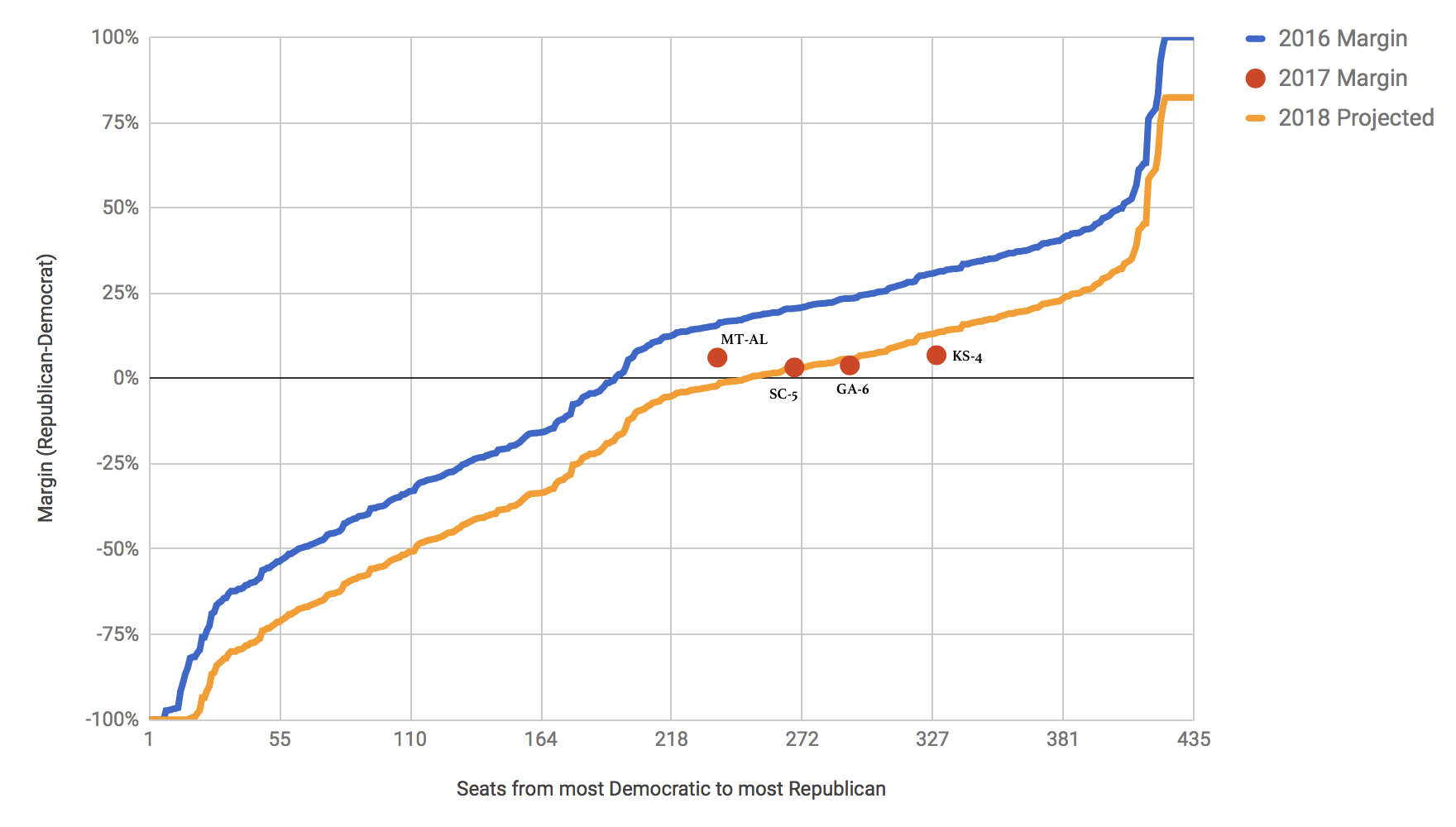It has been a couple days since the GA-6 and SC-5 election results, and there are other things in the news now, but I have still been frustrated by a lot of the spin about these races. Specifically, I’ve heard both Republicans and Democrats framing everything about how the Democrats have now lost four in a row, they are showing they can’t win, they are in trouble, they have to change their approach entirely to ever hope to win, etc. Republicans are of course crowing about their victories, but I’ve also heard Sanders-wing Democrats trying to make a case about how the results show that their wing of the party does better and the more centrist Democrats are doomed. Most of this is nonsense. As is my wont, I made a chart showing another way to look at things.
Now, to be fair, history has shown that drawing ANY conclusion from House special elections is dangerous. Special elections are special. And it is a long way until the 2018 elections still. The world in November 2018 is going to look a lot different than the world in June 2017. And we only have four data points. So take ANY conclusion based on this data with a huge grain of salt.
A bunch of the analysis I’ve seen has compared the House special election results to the 2016 PRESIDENTIAL results too. Huh? Why would you do that? Apples and oranges. Compare House races to House races instead. Now, even there, there are critical differences. Presence or absence of incumbents for instance. Lower turn out in special elections. All sorts of things. But at least compare the same kind of race.
In any case, when you do compare congressional race to congressional race, here are the numbers for the four special elections that had a Republican running against a Democrat. (I’m ignoring here the special election in California’s 34th that had two Democrats running against each other.)
- Kansas’s 4th
- 2016: Democrat 29.6%, Republican 60.7% -> Margin 31.1%
- 2017: Democrat 45.7%, Republican 52.5% -> Margin 6.8%
- Shift: 24.3% more Democratic
- Montana’s At-Large
- 2016: Democrat 40.5%, Republican 56.2% -> Margin 15.7%
- 2017: Democrat 44.1%, Republican 50.2% -> Margin 6.1%
- Shift: 9.6% more Democratic
- Georgia’s 6th (numbers as of election night)
- 2016: Democrat 38.3%, Republican 61.7% -> Margin 23.4%
- 2017: Democrat 48.1%, Republican 51.9% -> Margin 3.8%
- Shift: 19.6% more Democratic
- South Carolina’s 5th (numbers as of election night)
- 2016: Democrat 38.7%, Republican 59.2% -> Margin 20.5%
- 2017: Democrat 47.9%, Republican 51.1% -> Margin 3.2%
- Shift: 17.3% more Democratic
These shifts are large. 9.6% to 24.3% more Democratic depending on the district. The average of these four is a 17.7% move toward the Democrats.
Now, in real life, there are lots of factors in Congressional races. In real life districts will do all sorts of different things in 2018. But lets look at a simplified model for a minute. What if all 435 districts got 17.7% bluer? We get the chart below.

The blue line shows the election margins in all 435 districts based on the 2016 results, ordered from the most Democratic district to the most Republican district. Republican districts are positive, Democratic districts are negative. The place where the line crosses the X-axis is the number of Democrats in the House, currently 194. It takes 218 to control the House.
The red dots are the four special elections we have had. They are displaced downward from the blue line since the Democrats did better in the special elections than they did in 2016. The amount they are shifted downward represents the shift in the margin from 2016 to 2017.
The orange line is where we would be if all districts moved like the average of these four special elections. Again, we know this won’t happen exactly for any number of reasons, but this is to illustrate the degree of shift these four special elections represent.
With this amount of movement in the margins on the individual races, you end up with a 55 seat swing in the House, resulting in a Congress with 249 Democrats to 186 Republicans. That would be a substantial majority.
But you don’t even need that 17.7% shift. A 12.5% shift would be enough to just barely squeak by with a 218 seat majority. So, no, a Montana At-Large sized 9.5% shift would not be enough to give the Democrats the majority. But if they match the shift in any of the other three districts, the Democrats win the House.
Now, that may not happen. There are lots of reasons why that may not happen. But all the comments about how because they lost these four races the Democrats are doomed, or that they have to change their whole strategy to win, or that the Democratic brand is toxic, or anything of the sort… those takes are all just ridiculous on their face. What we’ve seen in these four races are massive movements toward the Democrats compared to just seven months ago… enough to show that a 12.5% movement, which might have seemed out of reach right after the November elections, is actually well within reach.
If Republicans want to protect themselves, they need to recognize the danger, and CHANGE their approach, and start defending their close districts differently, not just keep saying that “the Democrats keep losing!”. What the Republicans are doing is NOT working. Yes, they held these seats, but all these races were much closer than they “should have been”, and they had to put in a lot of resources to hold things even there. What they are doing is NOT working. Yes, the “Ha! Ha! We won!” act is fun, and it is nice to win and gloat about it, but if they are serious about holding the House, they need to be realistic about this as well.
Meanwhile, if Democrats want to capitalize on the trends, they need to be confident and be proud of these huge gains, not get paralyzed by self doubt and calls to change everything just because a 20% shift wasn’t quite enough to win Georgia’s 6th. It was a 20% shift!! That is HUGE! The fact that these districts went from places where Democrats lost by 16% to 31% to districts that Democrats lost by 3% to 7% shows that they should be pushing and competing hard in any district they lost by less than 25%, maybe even 30%. KS-4 showed it is possible for them to generate moves that size. They should attempt it.
![]() 1-Click Subscribe in iTunes
1-Click Subscribe in iTunes![]() View Podcast in iTunes
View Podcast in iTunes![]() View Raw Podcast Feed
View Raw Podcast Feed![]() Download MP3 File
Download MP3 File![]() Follow the podcast on Facebook
Follow the podcast on Facebook![]() Support us on Patreon
Support us on Patreon

